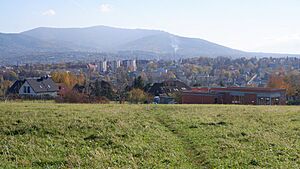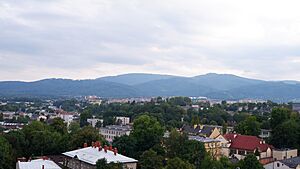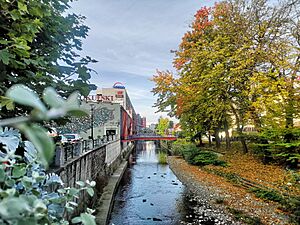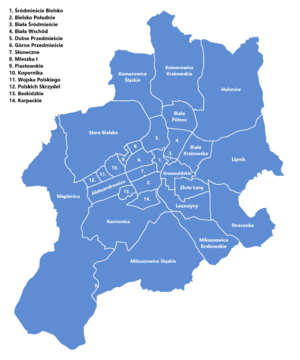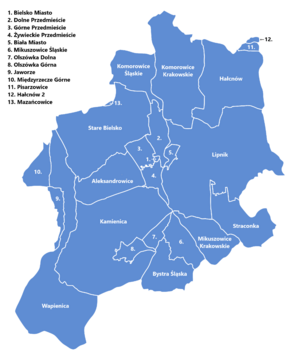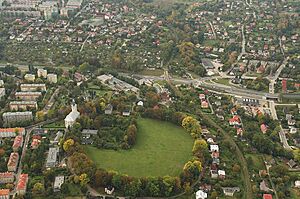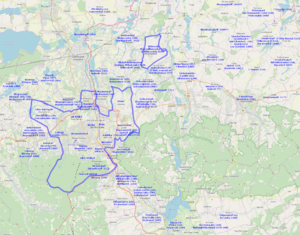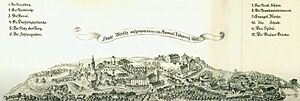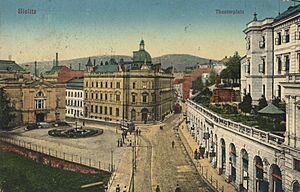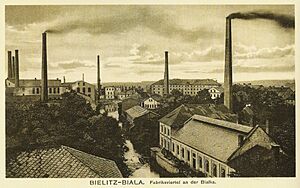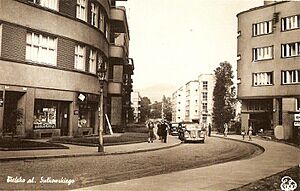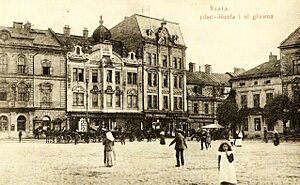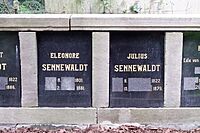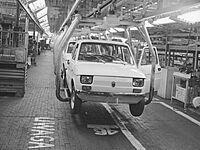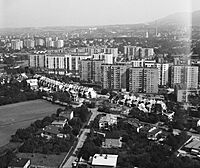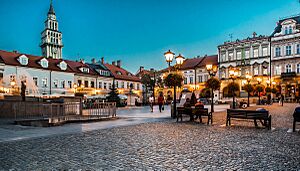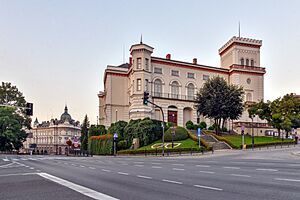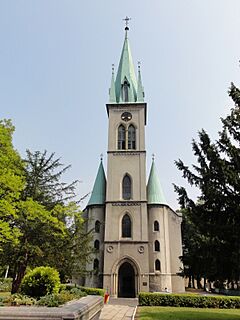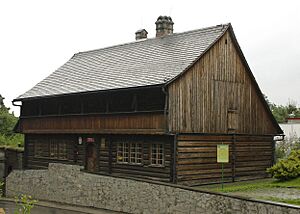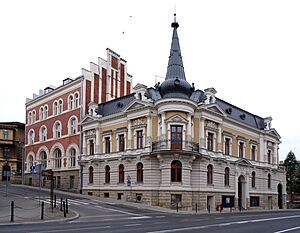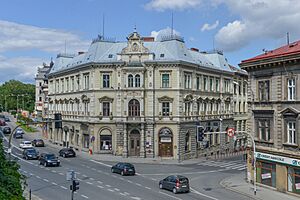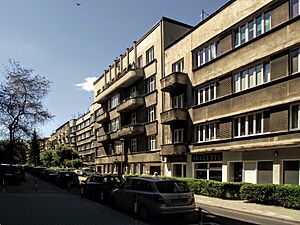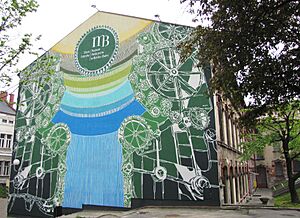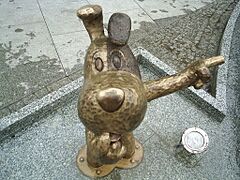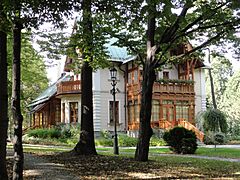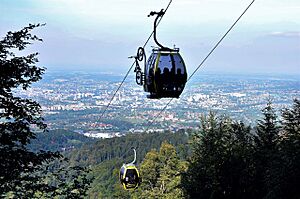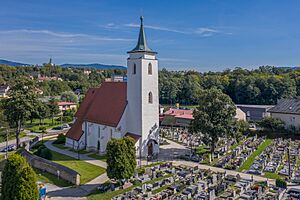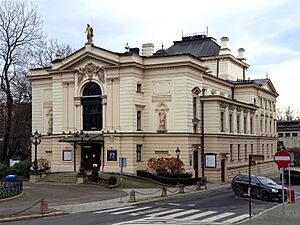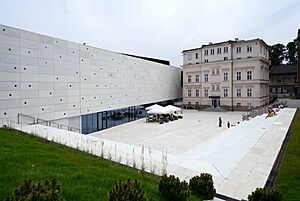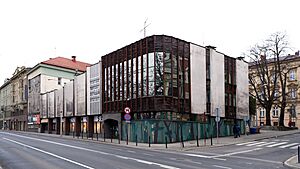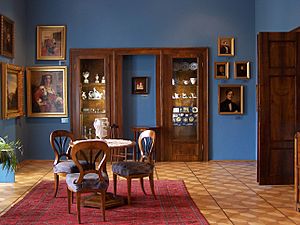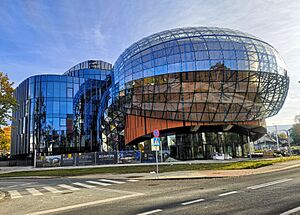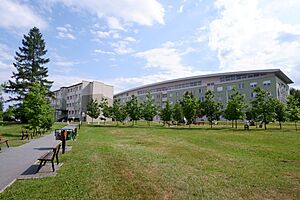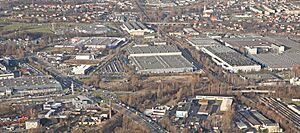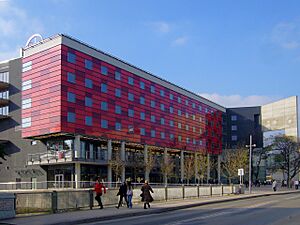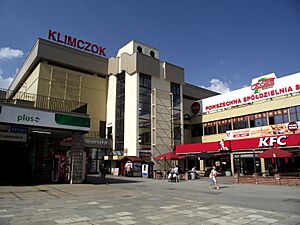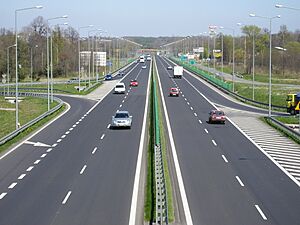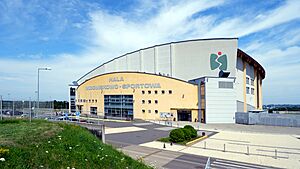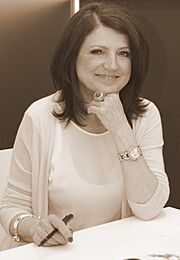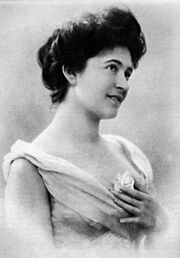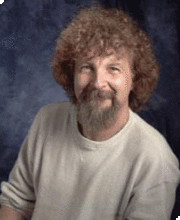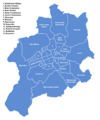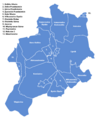Bielsko-Biała facts for kids
Quick facts for kids
Bielsko-Biała
Biylsko-Biołŏ (Silesian)
|
|||||
|---|---|---|---|---|---|

From upper left: Town Hall, Bielsko Castle & Bolesław Chrobry Square, 11 Listopada Street, Old Town – Kręta Street, Theatre Square, Martin Luther Church, Szyndzielnia gondola lift, Statue of Martin Luther, Bolek and Lolek Monument
|
|||||
|
|||||
| Country | |||||
| Voivodeship | |||||
| County | city county | ||||
| Town rights | Bielsko before 1312 Biała 1723 merged 1951 |
||||
| Area | |||||
| • City | 124.51 km2 (48.07 sq mi) | ||||
| Highest elevation | 1,117 m (3,665 ft) | ||||
| Lowest elevation | 262 m (860 ft) | ||||
| Population
(31 December 2022)
|
|||||
| • City | 166 765 |
||||
| • Density | 1,339.37/km2 (3,469.0/sq mi) | ||||
| • Metro | 335,000 | ||||
| Time zone | UTC+1 (CET) | ||||
| • Summer (DST) | UTC+2 (CEST) | ||||
| Postal code |
43-300 to 43-382
|
||||
| Area code(s) | +48 33 | ||||
| Car plates | SB | ||||
| Website | http://www.um.bielsko.pl | ||||
Bielsko-Biała is a city in southern Poland. About 166,765 people live here as of December 2022. This makes it the 22nd largest city in Poland.
The city covers an area of about 124.51 square kilometers. It is the main part of a larger area with around 335,000 people. Bielsko-Biała is important for the Bielsko County and several religious groups.
Bielsko-Biała is located north of the Beskid Mountains. It was formed in 1951 by joining two older towns: Bielsko and Biała. These towns were on opposite sides of the Biała River. This river also divides the historical regions of Silesia and Lesser Poland.
Bielsko's history goes back to the 13th century. Biała was founded later, in the 16th century. It became a city in 1723. Both towns grew a lot because of industries like textile and automotive. Today, Bielsko-Biała is part of the Silesian Voivodeship.
The city is a key center for administration, economy, and culture in its region. It is also an important place for business and travel. Many people visit because of its beautiful old buildings. Some call it "Little Vienna" because of its Revivalist and Art Nouveau style buildings. The city is also very close to the mountains, with fourteen mountain peaks inside its limits.
Contents
- About the Name of Bielsko-Biała
- Geography of Bielsko-Biała
- History of Bielsko-Biała
- Population of Bielsko-Biała
- Places to See in Bielsko-Biała
- Culture in Bielsko-Biała
- Education in Bielsko-Biała
- Economy of Bielsko-Biała
- Transportation in Bielsko-Biała
- Sports in Bielsko-Biała
- Famous People from Bielsko-Biała
- Images for kids
- See also
About the Name of Bielsko-Biała
Both names, Bielsko and Biała, come from an old Slavic word. This word, *bělъ, means "white". In modern Polish, it is biały.
The Biała River was likely named first. Its water probably looked "white," meaning bright and clear. Some people thought the name came from bleaching cloth. But the cloth industry was not big in the 13th century.
The German name, Bielitz-Biala, came from the Slavic name. In old documents, the town's name appeared in Polish, Czech, and German forms. Over time, Bielitz became the official German name. Bílsko was the Czech name. In Polish, people used Bielsko.
The name Biała was always Polish, even when the town was part of the Habsburg monarchy. The local German dialect used Beil. The Wymysorys language uses Byłc-Bejł. This is how local Germans called the two towns.
The combined name, Bielsko-Biała (Polish) or Bielitz-Biala (German), was used early on. It appeared in names of clubs, businesses, and newspapers in the 19th century. It was also used for the train station and on maps.
Geography of Bielsko-Biała
Location and Landscape
Bielsko-Biała is in the southern part of the Silesian Voivodeship. It sits on the border of two historical regions. These are Cieszyn Silesia (west side) and Lesser Poland (east side). The city covers 1.01% of the voivodeship's area.
The city stretches about 13 kilometers (8 miles) from east to west. It is about 17.5 kilometers (11 miles) from north to south. The city center is 31 kilometers (19 miles) from the Czech border. It is 35 kilometers (22 miles) from the Slovak border.
Most of Bielsko-Biała is in the Silesian Foothills. These are part of the Western Beskid Foothills. In the southern parts of the city, there are also mountains. These include the Little Beskids and the Silesian Beskids. Most of these mountain areas are protected. They are part of two landscape parks. They are also part of the Natura 2000 nature program.
The land in Bielsko-Biała is very varied. It has both hilly and mountainous areas. The main square, Bolesław Chrobry Square, is 313 meters (1,027 feet) above sea level. The lowest point is 262 meters (860 feet) at Komorowice Ponds. The highest point is Klimczok mountain, at 1,117 meters (3,665 feet).
The city has many hills and valleys. The Biała River valley runs through the center. There are 14 mountain peaks within the city limits. These include Dębowiec, Klimczok, and Szyndzielnia. There are also several caves, like Stołów Cave.
Climate and Weather
Bielsko-Biała has an oceanic climate. This means it has cold, wet winters and warm, wet summers. Sometimes, warm winds called Foëhn winds make winters milder.
The sunniest days are from late summer to early fall. In the 1960s, the city recorded 55 centimeters (22 inches) of snow.
| Climate data for Bielsko-Biała (1991–2020 normals, extremes 1951–present) | |||||||||||||
|---|---|---|---|---|---|---|---|---|---|---|---|---|---|
| Month | Jan | Feb | Mar | Apr | May | Jun | Jul | Aug | Sep | Oct | Nov | Dec | Year |
| Record high °C (°F) | 18.0 (64.4) |
19.0 (66.2) |
22.8 (73.0) |
29.0 (84.2) |
30.7 (87.3) |
33.9 (93.0) |
35.4 (95.7) |
36.4 (97.5) |
34.1 (93.4) |
26.4 (79.5) |
23.1 (73.6) |
18.3 (64.9) |
36.4 (97.5) |
| Mean daily maximum °C (°F) | 2.2 (36.0) |
3.5 (38.3) |
7.6 (45.7) |
14.1 (57.4) |
18.6 (65.5) |
21.9 (71.4) |
24.0 (75.2) |
23.9 (75.0) |
18.6 (65.5) |
13.5 (56.3) |
8.2 (46.8) |
3.3 (37.9) |
13.3 (55.9) |
| Daily mean °C (°F) | −0.9 (30.4) |
0.2 (32.4) |
3.5 (38.3) |
9.0 (48.2) |
13.4 (56.1) |
16.8 (62.2) |
18.7 (65.7) |
18.5 (65.3) |
13.8 (56.8) |
9.3 (48.7) |
4.8 (40.6) |
0.3 (32.5) |
9.0 (48.2) |
| Mean daily minimum °C (°F) | −3.9 (25.0) |
−3.0 (26.6) |
−0.2 (31.6) |
4.1 (39.4) |
8.4 (47.1) |
12.0 (53.6) |
13.7 (56.7) |
13.5 (56.3) |
9.6 (49.3) |
5.7 (42.3) |
1.6 (34.9) |
−2.6 (27.3) |
4.9 (40.8) |
| Record low °C (°F) | −27.4 (−17.3) |
−29.6 (−21.3) |
−20.7 (−5.3) |
−8.5 (16.7) |
−3.1 (26.4) |
−0.2 (31.6) |
4.3 (39.7) |
2.6 (36.7) |
−2.4 (27.7) |
−8.6 (16.5) |
−19.8 (−3.6) |
−26.0 (−14.8) |
−29.6 (−21.3) |
| Average precipitation mm (inches) | 45.2 (1.78) |
46.6 (1.83) |
58.6 (2.31) |
67.8 (2.67) |
128.7 (5.07) |
131.6 (5.18) |
143.2 (5.64) |
92.0 (3.62) |
110.2 (4.34) |
72.7 (2.86) |
56.8 (2.24) |
45.2 (1.78) |
998.3 (39.30) |
| Average extreme snow depth cm (inches) | 21.2 (8.3) |
27.4 (10.8) |
19.7 (7.8) |
9.9 (3.9) |
0.5 (0.2) |
0.0 (0.0) |
0.0 (0.0) |
0.0 (0.0) |
0.0 (0.0) |
4.1 (1.6) |
9.5 (3.7) |
14.2 (5.6) |
27.4 (10.8) |
| Average precipitation days (≥ 0.1 mm) | 17.03 | 16.34 | 15.57 | 13.93 | 16.80 | 15.73 | 15.60 | 12.77 | 13.13 | 14.20 | 14.57 | 15.77 | 181.44 |
| Average snowy days (≥ 0 cm) | 26.7 | 25.3 | 20.7 | 6.5 | 0.2 | 0.0 | 0.0 | 0.0 | 0.0 | 2.8 | 10.9 | 23.5 | 116.6 |
| Average relative humidity (%) | 81.4 | 78.5 | 73.6 | 67.3 | 71.4 | 72.8 | 71.9 | 72.3 | 77.5 | 79.0 | 80.8 | 82.4 | 75.7 |
| Source 1: Institute of Meteorology and Water Management | |||||||||||||
| Source 2: Meteomodel.pl (records, relative humidity 1991–2020) | |||||||||||||
Air Quality in the City
Bielsko-Biała has had some issues with air pollution. In 2016, it was ranked as one of the more polluted cities in the European Union. By 2020, it was fifth in Poland.
The main cause of air pollution is old heating systems. Many homes still burn coal for heat. This creates smog, especially in winter. Smog can harm people's health and damage old buildings.
However, the air quality is getting better. The city has a "Low Emission Economy Plan" since 2015. In 2020, 454 coal heaters were replaced with gas or district heating. The number of days with high pollution has gone down.
Pollution from cars is also a problem in busy areas. Pollutants from nearby towns can also affect the city's air.
The quality of water in the rivers, Biała and Wapienica, is also improving. The city has three air monitoring stations. It also has 36 air quality sensors to check pollution levels.
City Districts
Bielsko-Biała is divided into 30 official neighborhoods called osiedla.
|
|
There is also another division into obręby ewidencyjne, or cadastral areas. These areas show the old borders of towns that joined Bielsko-Biała. They also show the historical parts of Bielsko. These include:
- Bielsko Miasto (Old Town of Bielsko)
- Biała Miasto (original Biała)
- Dolne Przedmieście
- Górne Przedmieście
- Żywieckie Przedmieście
- Aleksandrowice
- Hałcnów and Hałcnów 2
- Lipnik
- Kamienica
- Komorowice Śląskie
- Komorowice Krakowskie
- Mikuszowice Śląskie
- Mikuszowice Krakowskie
- Olszówka Dolna
- Olszówka Górna
- Stare Bielsko
- Straconka
- Wapienica
Some areas from nearby villages were also added to Bielsko-Biała. The names of osiedla and obręby ewidencyjne can sometimes be confusing.
History of Bielsko-Biała
Early History of Bielsko
People have lived in Bielsko since about 1400 BC. Old tools like wooden tools and stone axes have been found. Between 1933 and 1938, a fortified settlement was found in Stare Bielsko. This settlement was from the 12th to 14th centuries. The people there made iron and were skilled metalworkers.
The center of Bielsko probably started in the early 13th century. A castle, which is still there today, was built on a hill.
In the late 13th century, dukes from Opole invited German settlers. These settlers created villages on both sides of the Biała River. These villages included Bielitz (now Stare Bielsko) and Lipnik. These German-speaking areas remained for centuries. They formed a "German language island."
After 1281, Bielsko became part of the Duchy of Teschen. In 1312, Bielsko officially became a town. The Biała River became a border again in 1315. It separated the Duchy of Oświęcim from Cieszyn. For centuries, the Biała River was the border between Silesia (part of the Holy Roman Empire) and Lesser Poland (part of the Kingdom of Poland).
In 1526, Bielsko became part of the Habsburg monarchy. It was inherited by the Austrian Habsburgs. Later, in 1752, a Polish noble family, the Sułkowski family, bought the Duchy of Bielsko. They owned the castle until World War II.
Bielsko was one of the first towns in the region to accept Martin Luther's teachings. This happened in the late 1530s. Bielsko had a strong Protestant community. In 1587, they gained the right to have only Lutheran services.
Even after the Thirty Years' War, Bielsko remained Protestant. The attempt to bring people back to Catholicism was not very successful. Lutherans held services secretly or in forests. In 1781, Emperor Joseph II allowed more religious freedom. An Evangelical area was built north of the center. This area, called the Bielsko Zion, became a Protestant cultural hub.
In 1900, a monument to Martin Luther was put up there. It was one of only two in Austria-Hungary at the time. Today, it is the only one in Poland. By the late 19th century, Lutherans were no longer the majority. Many Catholics and Jewish people moved to the city.
After 1742, Bielsko remained with the Habsburg monarchy. In 1849, Bielsko became a political district. In 1870, it became a self-governing city.
The city grew a lot in the 19th century. This was mainly due to the textile industry. It was the third largest textile center in Austria-Hungary. New buildings, villas, and public spaces were built. Many were inspired by Vienna's architecture. This is why Bielsko-Biała is called "Little Vienna."
A local architect, Carl Korn, greatly influenced the city's look. In 1855, a railway line was built to Bielsko. It was later extended. A 268-meter (879 feet) tunnel was built under the city center. In 1895, an electric tram line started. It connected the train station to Cygański Las, a forest-park.
The city's population growth was slower than in other industrial areas. Many workers lived in nearby villages. In 1910, Bielsko had 18,568 people. Most spoke German (84.3%). Many were Catholic (55.9%) or Lutheran (27.6%).
After World War I, Bielsko became part of Poland. It was part of the Silesian Voivodeship. More Polish people moved in, but the city kept its German character. In the 1930s, some German citizens formed an anti-Polish group.
During the time between the wars, many new buildings were constructed. A new modern residential area was built in 1934. The first Polish high school opened in 1927. In 1938, Aleksandrowice joined the city. An airport and pilot school were built there.
History of Biała
Biała's history began in the late 16th century. It was first mentioned in 1564 as a small settlement. It had thirteen houses near the Biała River. It was part of the Kingdom of Poland.
The first residents likely came from Bielsko's suburbs. They moved to build new homes. The settlement grew with refugees from Silesia during the Thirty Years' War.
Biała officially became a town in 1723. It had only 40 houses and about 300 residents. Most were German-speaking Lutherans. A new town layout was made, with a rectangular market square. This is now Wojska Polskiego Square.
In 1772, Biała was taken by the Habsburg Empire. It became part of Galicia. The town changed a lot in the 1780s. A new road, now 11 Listopada Street, was built. The New Market, now Wolności Square, was also created.
Biała's borders were limited by disputes with the Lipnik village. Lipnik finally joined Biała in 1925. This made Biała's area sixteen times larger. Its population also increased greatly.
In the 19th century, Biała and Bielsko became one industrial area. The textile industry was very important. From 1867, Biała was the capital of Biała County. Around 1900, many "Vienna-like" buildings were built in Biała. This included the grand Neo-Renaissance town hall.
In 1910, Biała had 8,668 people. Most spoke German (69.3%). Many were Catholic (72.1%) or Jewish (17.7%).
After 1918, Biała became part of the Second Polish Republic. From 1925, its official name was Biała Krakowska.
Modern Bielsko-Biała
| Historical population | ||
|---|---|---|
| Year | Pop. | ±% |
| 1880 | 20,312 | — |
| 1890 | 22,195 | +9.3% |
| 1900 | 24,854 | +12.0% |
| 1910 | 27,236 | +9.6% |
| 1921 | 36,857 | +35.3% |
| 1931 | 47,465 | +28.8% |
| 1939 | 54,723 | +15.3% |
| 1946 | 45,289 | −17.2% |
| 1960 | 75,527 | +66.8% |
| 1970 | 105,700 | +39.9% |
| 1980 | 163,741 | +54.9% |
| 1990 | 181,278 | +10.7% |
| 2000 | 178,611 | −1.5% |
| 2010 | 175,008 | −2.0% |
| 2020 | 169,756 | −3.0% |
| For the period before 1951, aggregated data for Bielsko and Biała. Source: Polska w liczbach web site for data since 1995, Monografia Bielska-Białej for data before 1945, Roczniki statystyczne for data 1945–1990 | ||
Bielsko and Biała worked as one city for a long time. But they were officially joined by the Nazi authorities in 1939. Biała became a district of Bielsko. During World War II, the city was part of the Third Reich.
Many Polish teachers were sent to concentration camps. Many Jewish residents were killed in the Auschwitz extermination camp. Less than 1,000 of the city's nearly 8,000 Jewish people survived. The city itself was not heavily damaged during the war.
After World War II, the city's population changed. Most German people were expelled. Many Poles from eastern areas joined the city. New settlers also came from central Poland.
The new Polish government first brought back the old borders. But soon, Bielsko and Biała were officially combined. The new city, Bielsko-Biała, was created on January 1, 1951.
After the war, the city remained a major textile center. New industries also grew. In 1946, the Gliding Institute was founded. In 1948, a car engine plant started. This plant became the FSM Automobile Factory in 1972. It produced the Polski Fiat 126p, known as Maluch.
A huge industrial area was built in the north. Thousands of people moved to Bielsko-Biała for work. The city's population grew rapidly in the 1970s. New housing estates were built for these new residents. Several nearby towns also joined Bielsko-Biała.
Bielsko-Biała became famous for its Studio Filmów Rysunkowych (Animated Film Studio). It was founded in 1947. This studio created popular children's TV series. These include Reksio and Bolek i Lolek.
A major strike happened in Bielsko-Biała in January 1981. Workers from a textile factory led it. They forced many local leaders to resign. This strike was very important for the Solidarity movement.
From 1975 to 1998, Bielsko-Biała was the capital of the Bielsko-Biała Voivodeship. This region was sometimes called Podbeskidzie. In 1998, the administrative divisions changed. Bielsko-Biała became part of the Silesian Voivodeship.
After 1989, the city faced economic challenges. The textile industry almost disappeared. The car factory, bought by Fiat, focused on making car parts. The old town also needed repairs.
But the city started to recover around 2002. A large shopping mall, Galeria Sfera, was built. It replaced old textile factories. Bielsko-Biała has returned to economic growth. Like other cities, it is seeing people move to the suburbs.
Population of Bielsko-Biała
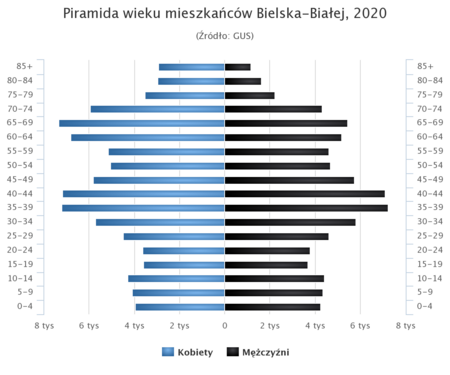
On December 31, 2021, Bielsko-Biała had 168,835 residents. There were more women (52.8%) than men (47.2%). For every 100 men, there were 112 women.
Most residents (56.4%) were of working age. About 17.5% were children. About 26.0% were retired. The city's population makes up 3.77% of the Silesian Voivodeship. There are 1,356 people per square kilometer.
More people are dying than being born in the city. In 2020, 1,519 children were born, and 2,129 people died. The birth rate was 1.44, which is similar to Poland's average. More people are moving out of the city than moving in.
When Bielsko and Biała merged in 1951, the city had about 60,000 people. The population grew quickly in the 1970s. This was due to industrial growth and adding nearby towns. The population reached its highest in 1991, with 184,421 people.
Since then, the population has slowly decreased. Between 2002 and 2021, it dropped by 5.1%. Experts predict the population will continue to fall.
In the 2021 census, 99.30% of residents said they were Polish. Some also said they were Silesian (0.66%), German (0.21%), or Ukrainian (0.20%).
Most people (99.70%) speak Polish at home. Other languages spoken include English (2.30%) and German (0.44%).
Places to See in Bielsko-Biała
The Old Town of Bielsko is on Town Hill. It has an oval shape with streets leading from the rectangular Market Square. This design is typical for towns founded in the 13th century. Most buildings look like they did in the early 19th century. This was after fires in 1808 and 1836.
Podcienie Street has old 18th-century arcades. Schodowa Street is a unique step street. Parts of the old town walls from the 16th century can still be seen.
Two important historical buildings are in the Old Town:
- Bielsko Castle: Also called the Castle of the Sułkowski Princes. The Sułkowski family lived here from 1752 to 1945. The castle dates back to the Middle Ages. Its current look comes from changes made between 1855 and 1864. It now houses the Historical Museum of Bielsko-Biała.
- Cathedral of St. Nicholas: A Catholic church that has been here since the Middle Ages. It was rebuilt between 1909 and 1912. In 1992, it became the main church for the new diocese of Bielsko and Żywiec.
North of the Old Town is the Bielsko Zion. This is a Lutheran area started after Emperor Joseph II allowed more religious freedom. Important Lutheran sites here include:
- Church of the Saviour: Built between 1782 and 1790. It was expanded several times.
- Luther Monument: Unveiled in 1900. It is the only one in Poland today.
- Old Lutheran Cemetery and school buildings from the 19th century.
West of the Old Town is the Upper Suburb (Górne Przedmieście). This was a clothmakers' area. It has small, old buildings. The wooden Weaver's House is very special. It has a museum about the life of clothiers before factories. The Neo-Renaissance Villa Bartelmuss from 1872 is also here.
The Lower Suburb (Dolne Przedmieście) is to the north. It has many buildings from the late 19th and early 20th centuries. These Revivalist and Art Nouveau buildings give Bielsko-Biała its "Little Vienna" nickname. Some examples are:
- Architect Carl Korn's own house (1883)
- Villa Sixt (1883)
- Main Train Station (1890)
- Theatre (1890)
- Hotel President (1893)
- Main Post Office (1898)
Bolesława Chrobrego Square is the main square today. It is between the Bielsko Castle and the old Municipal Savings Bank.
The historic center of Biała is along 11 Listopada Street. This street was built in the 1780s. It has many old townhouses with Baroque and Neoclassical styles. This street is now a main walking area. It passes through two historic markets: Wojska Polskiego Square and Wolności Square.
Biała also has two main churches from the late 18th century:
- The Lutheran Church of Martin Luther (1782–1788).
- The Catholic Church of the Divine Providence (1769).
Biała's Town Hall was built between 1895 and 1897. It is in Neo-Renaissance style. Today, it is the City Hall for the combined city. Other important buildings from around 1900 in Biała include:
- The former Polish elementary school (1898).
- Frog House (Kamienica Pod Żabami, 1903), a famous Art Nouveau building.
- The former hotel Under the Eagle (Hotel Pod Orłem, 1904).
Buildings from the time between the World Wars are also important. A large area of Modernist housing was built from 1934. Public buildings from the 1920s and 1930s include:
- Nicolaus Copernicus High School (1925–1927).
- The fire station (1928).
Old industrial buildings are mixed with city areas. You can see them near the Biała River and in the Żywiec Suburb. The Old Factory Museum is in a former textile factory. There are also old vodka factories turned into lofts. A workers' housing estate with familoks was built between 1892 and 1911.
Newer buildings include the Grunwaldzkie housing estate (1951–1957) and the bus station (1972). The Galeria Sfera shopping mall (2000–2001) is a modern building. The blob concert hall Cavatina Hall (2019–2021) is also new.
Many Murals have been painted in the city. There is a street art tourist trail with 25 sites. The "Fairytale Bielsko-Biała" trail has small statues of cartoon characters. These characters are from films made by Studio Filmów Rysunkowych. You can find statues of Reksio, Bolek and Lolek, and the Wawel Dragon.
Cygański Las (Gypsy Forest) is a forest park. It is located at the foot of Kozia Góra and Równia mountains. In the late 19th century, it was made into a walking area. It was connected to the city center by a tram line until 1971. It is still very popular today. Nearby, Błonia is a sports and recreation area. Many old summer villas are also in this area.
Szyndzielnia mountain, at 1,001 meters (3,284 feet), is another popular place. You can reach it by a gondola lift. A tourist hostel opened there in 1897. On Dębowiec mountain, at 686 meters (2,251 feet), there is a ski complex and a toboggan run. Both mountains offer great views of the city.
In Stare Bielsko, you can find the Catholic Church of St. Stanislaus. It was built around 1380. It has old Gothic paintings and a valuable altar. The Lutheran Church of Saint John the Baptist from 1818 is also there. Next to it are remains of a medieval hillfort.
Other important religious sites include:
- St. Barbara Church in Mikuszowice Krakowskie (wooden, built in 1690).
- Visitation of the Blessed Virgin Mary Church in Hałcnów (18th century).
There is also a well-preserved Jewish cemetery in Aleksandrowice. It has a Moorish-style pre-burial house from 1885.
Culture in Bielsko-Biała
Cultural Centers
The main public places for culture are:
- Maria Koterbska Bielsko-Biała Cultural Centre (BCK)
- Regional Cultural Centre (ROK)
- Municipal House of Culture (MDK), which has thirteen facilities
- Military Cultural Centre "Soldier's House"
- Cooperative Cultural Centre BEST
Theatres and Cinemas
The Polish Theatre is a drama theater. It started after World War II. It uses the historic building from 1890. The Banialuka Puppet Theatre was founded in 1947. It is one of the best puppet theaters in Poland. Other groups also put on plays.
Bielsko-Biała is known for Studio Filmów Rysunkowych (SFR). This is an animation studio that started in 1947. It made famous cartoons like Reksio and Bolek and Lolek. A new Interactive Fairy Tale and Animation Centre (OKO) opened in 2024. It is a museum and learning center about the studio's work. It also has the Kreska cinema, which shows art films.
The city also has two large movie theaters: Helios and Cinema City.
Art Galleries
The biggest art gallery is Galeria Bielska BWA. It opened in 1994. It is in the former Artists' Pavilion. Since 2020, it also has a second location in Villa Sixt. The Aquarium club café at BWA hosts many events.
Other private galleries include:
- Wzgórze Gallery (since 1987)
- Contemporary Art Gallery
- Ars Nova sculpture and ceramics studio (since 1991)
- Photography Gallery B&B (since 1992)
Museums
The Historical Museum of Bielsko-Biała is in the Bielsko Castle. It has nine parts, including:
- History of Bielsko-Biała and its surroundings (old artifacts).
- Rooms showing how people lived in the 19th century.
- Collections of weapons and paintings.
- Art from the Bielsko-Biała region.
The museum also has three other locations:
- The Old Factory (Stara Fabryka): Shows the history of Bielsko-Biała's industry. It has old machines in a former textile factory.
- The Weaver's House (Dom Tkacza): Shows how a weaver's house and workshop looked in the 18th century.
- Fałatówka: A museum about the artist Julian Fałat in his former villa.
There are also several private museums:
- Automotive Museum: Has a small collection of old cars.
- Fiat 126p Museum: Shows Fiat 126p cars made in Bielsko-Biała.
- Museum of Armored Weapons and Militaria: Has military vehicles.
- Museum of Minerals "Treasures of the Earth".
The Władysław Reymont Museum of Literature was recently closed for renovation. It had handwritten copies of Władysław Reymont's works.
Music
In 2021, the modern Cavatina Hall concert hall opened. It is designed for philharmonic music.
Several music groups are part of the Maria Koterbska Bielsko-Biała Cultural Centre. These include:
- Bielsko-Biała Chamber Orchestra
- Bielsko-Biała Brass Band
- Bielsko-Biała Chamber Choir
- "Bielsko" Song and Dance Ensemble
- Children's "Jarzębinki" Dance and Song Ensemble
The Telemann Orchestra has been active since 1993. It promotes early music.
Music bands from Bielsko-Biała include Akurat and Eye for an Eye.
Events and Festivals
- Jazz Blizzard (Bielska Zadymka Jazzowa): An annual jazz music festival since 2002. It takes place in February or March.
- Jazz Autumn (Jazzowa Jesień): Another annual jazz festival in late November or early December.
- International Festival of Puppetry Art: A theater festival held every two years in May since 1966.
- Bielsko Autumn (Bielska Jesień): A national painting competition since 1962. It is now held every two years.
- Bielsko-Biała Festival of Visual Arts: A visual arts competition held every four years since 2007.
- FotoArtFestival: An international art photography festival held every two years in October.
- Henryk Górecki Festival of Polish Composers: A classical music festival held annually in October.
- International Sacred Music Festival "Sacrum in Musica": A religious music festival held annually in April.
- International Choir Festival "Gaude Cantem": A choir competition held annually in October.
- "Fermenty" Comedy Festival: A comedy festival held annually in September.
- Week of Beskid Culture: An international folklore festival held every year in July/August. Some events are in Bielsko-Biała.
- Beskidy Oldtimer Rally: An annual classic rally held in July since 1977. Old cars are shown at the Town Hall Square.
- Days of Bielsko-Biała: A series of cultural events in late August and early September.
- Summer with Culture: Weekend outdoor concerts during July and August.
Education in Bielsko-Biała
The University of Bielsko-Biała was founded in 2001. It used to be a branch of the Technical University of Łódź. As of 2023, it has five faculties (departments). These include Mechanical Engineering, Computer Science, and Health Sciences. About five thousand students studied there in 2022/2023. The campus is in the southern part of the city.
In 2023, a branch of the Medical University of Silesia also opened in the city.
There are also five private colleges in Bielsko-Biała:
- Higher School of Computer Science and Management
- Higher School of Finances and Law
- Józef Tyszkiewicz Higher School of Bielsko-Biała
- Higher School of Administration (linked to the Lutheran community)
- Higher School of Economics and Humanities
Economy of Bielsko-Biała
At the end of 2021, there were almost 28,000 businesses in Bielsko-Biała. Most (96.13%) were private businesses. Most businesses had fewer than 9 employees. Only three companies had more than a thousand employees.
The unemployment rate was very low, at 2.2% in late 2021. This was lower than the national average. The average monthly salary was PLN 5,789.65. This was about 96.5% of the average salary in Poland.
Many people travel to Bielsko-Biała for work. About 24,302 people came from outside the city to work.
Historically, Bielsko-Biała was a big industrial center. The textile industry was very important. But it almost disappeared after 1989. A few factories still continue these traditions. These include a brush factory, a shoe factory, and a zipper factory.
Today, the largest industrial area is in the north. This was the former Fabryka Samochodów Małolitrażowych car factory. It is now part of Stellantis Poland. While cars are made in Tychy, the Bielsko-Biała plant produces engines. This area is part of the Katowice Special Economic Zone. Other areas in Wapienica, Komorowice, and Lipnik are also part of this zone. In 2021, twenty businesses in the zone employed over 4,600 workers.
Other important factories include Bielmar, which makes margarines and oils. The Silesian Vodka Factory POLMOS Bielsko-Biała makes Extra Żytnia vodka.
Bielsko-Biała has many shopping areas. In 2019, it had 1,151 square meters (12,389 square feet) of retail space per 1,000 residents. The largest shopping mall is Galeria Sfera. It has two buildings built on old factory sites.
Other big shopping places include the "Klimczok" Cooperative Department Store. It was built in 1988 and was one of the largest in Poland. Gemini Park and Sarni Stok are also large malls. There are also hypermarkets like Auchan and Kaufland.
The traditional shopping street is 11 Listopada Street. However, fewer stores are there now. This is often blamed on the large shopping malls. Outdoor markets are on Lompy and Broniewskiego Street.
The most important trade fairs in Bielsko-Biała are:
- ENERGETAB Bielsko International Energy Fair.
- "Twój Dom" International Construction Fair.
- "Instal-System" Fair of Heating Techniques and Energy Saving.
- EKOStyl International Fair.
These fairs are usually held at the multi-purpose hall on Karbowa Street.
Transportation in Bielsko-Biała
Train Travel
Trains first came to the city in 1855. Today, three railway lines cross the city:
Local trains go to Katowice and Zwardoń. Other trains go to Kalwaria Zebrzydowska and Kraków. Bielsko-Biała also has express train connections to major Polish cities.
The main train station is Bielsko-Biała Główna. It is in the northern part of the city center. There are twelve train stations and stops in the city. Eight of them are open for passengers.
Road Travel
Bielsko-Biała is close to the Czech and Slovak borders. Two expressways connect it to neighboring countries:
- Expressway S1 goes to Slovakia.
- Expressway S52 goes to the Czech Republic.
Bielsko-Biała is also connected to the rest of Poland by National road 1. This road goes to Tychy and Katowice. National road 52 connects Bielsko-Biała with Kraków.
A major road interchange is north of Bielsko-Biała. This is where S1, DK1, and S52 meet.
The Downtown Western Bypass helps traffic flow around the city center.
In June 2021, Bielsko-Biała had many registered vehicles. It was the ninth most motorized city in Poland.
Public Transportation
The city's public transport started in 1895. It had a tram network until 1972. Since 1927, it has also had a bus network. Now, only buses are used.
The main bus company is MZK Bielsko-Biała. In 2023, it ran 40 daily and two night bus lines. Some lines went outside the city limits. Other bus companies also serve some stops in Bielsko-Biała.
Regional bus travel is handled by Komunikacja Beskidzka. This company started in 2021. Its buses go to nearby towns. The main bus station is on Warszawska Street.
Smaller private bus companies also operate in the region. Their stops are near the main station.
Airports Near Bielsko-Biała
There are three international airports within 90 kilometers (56 miles) of Bielsko-Biała. They offer flights to major European cities:
- Katowice International Airport
- Kraków John Paul II International Airport
- Ostrava Leoš Janáček Airport
In Aleksandrowice, there is a small airport. It is used for sports by the Aeroclub of Bielsko-Biała. Another airport nearby is Bielsko-Biała Kaniów Airport.
Sports in Bielsko-Biała
The city has hosted several sports events:
- 1978 UEFA European Under-18 Championship
- 2009 European Youth Olympic Winter Festival
- 2019 FIFA U-20 World Cup
- 2023 European Games
Major Sports Teams and Athletes
- TS Podbeskidzie Bielsko-Biała: Men's football team. They play in Poland's third division.
- BKS Stal Bielsko-Biała:
- Women's volleyball team: They play in the highest league in Poland. They have won Polish Championships many times.
- Men's football team: They play in a regional league.
- BBTS Bielsko-Biała: Men's volleyball team. They play in the Plus Liga. They won the Polish Cup in 1994.
- BTS Rekord Bielsko-Biała: Men's futsal team. They play in the Futsal Ekstraklasa. They have won Polish Championships many times. Their women's futsal team also plays in the top league.
- Podbeskidzie Kuloodporni Bielsko-Biała: An amputee football club. They won the Polish Champions title in 2019.
- KS Sprint: A track and field club.
- KS Gwardia Bielsko-Biała: A judo club.
- Sebastian Kawa: A member of the Bielsko-Biała Aeroclub. He is a sixteen-time World Gliding Champion. He is ranked number one in the world for glider pilots.
Famous People from Bielsko-Biała
- Shlomo Avineri (born 1933): A political scientist and philosopher.
- Carl Josef Bayer (1847–1904): A chemist who invented the Bayer process.
- Maurice Bloomfield (1855–1928): A language expert and Sanskrit scholar.
- Peter Michal Bohúň (1822–1879): A painter.
- Heinrich Conried (1855–1909): A theater manager.
- Marek Dopierała (born 1960): A sprint canoeist and Olympic medalist.
- Urszula Dudziak (born 1943): A jazz singer.
- Piotr Fijas (born 1958): A ski jumper and world record holder.
- Mateusz Gamrot (born 1990): A mixed martial artist.
- Adolf Hyła (1897–1965): A painter, known for the Divine Mercy image.
- Jacek Koman (born 1956): An actor and singer.
- Maria Koterbska (born 1924): A singer.
- Selma Kurz (1874–1933): A famous opera singer.
- Jacek Lech (1947–2007): A singer.
- Zbigniew Preisner (born 1955): A film music composer.
- Renata Przemyk (born 1966): A singer and songwriter.
- Aneta Sablik (born 1989): A singer and songwriter.
- Artur Schnabel (1882–1951): A classical pianist and composer.
- Hugo von Seeliger (1849–1924): An astronomer.
- Kriss Sheridan (born 1989): A singer, actor, and model.
- Bohdan Smoleń (1947–2016): A comedian and actor.
- Josef Strzygowski (1862–1941): An art historian.
- Gerda Weissmann Klein (1924–2022): A Holocaust survivor and writer.
- Karol Wojtyła (1879–1941): An army officer, father of Pope John Paul II.
- Jakub Wolny (born 1995): A ski jumper.
- Aleksander Zawadzki (1798–1868): A naturalist.
- Emil Zegadłowicz (1888–1941): A poet and writer.
- Wojciech H. Zurek (born 1951): A theoretical physicist.
Images for kids
See also
 In Spanish: Bielsko-Biała para niños
In Spanish: Bielsko-Biała para niños








